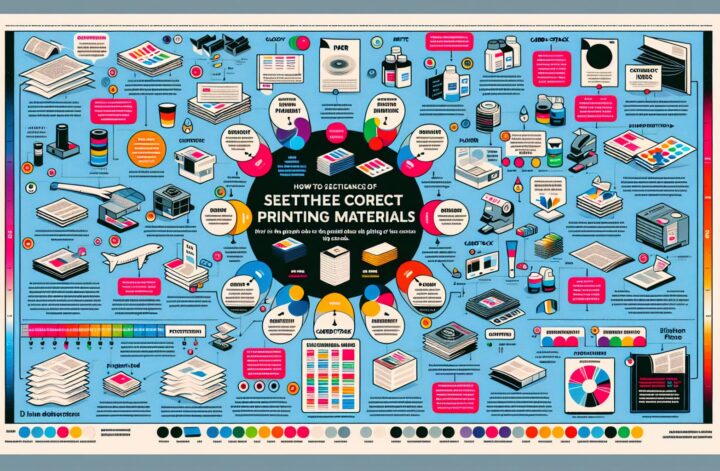When it comes to printing materials, there is a wide array of options available to cater to different needs and preferences. From paper and cardstock to fabrics and plastics, choosing the right material is crucial for achieving the desired outcome in any printing project. In this comprehensive guide, we will delve into various printing materials, their characteristics, and their most suitable applications. So, let’s explore the realm of printing materials!
Introduction to Printing Materials
Printing materials refer to the substrates or surfaces onto which ink or toner is applied to create text, images, or designs. These materials play a vital role in determining the final appearance, durability, and overall quality of the printed output. Depending on the medium being printed on, different materials offer distinct advantages and limitations.
Paper and Cardstock
Paper: Paper is the most commonly used material for printing purposes. Available in a multitude of weights, colors, and finishes, it is suitable for a wide range of applications including documents, brochures, flyers, and invitations. Standard printer paper typically has a weight of 20 lb, while heavier papers like cardstock can go up to 110 lb or more. Paper is relatively inexpensive and easily accessible, making it an excellent option for everyday printing needs.
Cardstock: Cardstock is a heavier and stiffer type of paper, often used to create business cards, postcards, invitations, and greeting cards. With its durability and a wide range of finishes and colors, cardstock offers a more professional and luxurious feel to printed products. It is available in different thicknesses, commonly measured in points. Thicker cardstock, such as 100-130 lb, is commonly used for premium quality prints.
Specialty Papers
Besides standard paper and cardstock, various specialty papers are specifically designed to meet specific printing requirements. Let’s explore a few popular ones:
Photo Paper: As the name suggests, photo paper is designed explicitly for printing high-quality photographs. With its smooth finish and various luster levels, it delivers vibrant colors, sharp details, and excellent image contrast. Photo paper often comes in glossy or matte finishes, and certain types are even waterproof and smudge-resistant.
Transfer Paper: Transfer paper is commonly used for printing designs or images that can be transferred onto other surfaces, such as fabrics or ceramics. In this process, the printed design is transferred by applying heat and pressure, allowing for customizing T-shirts, mugs, and other personalized items.
Sticker Paper: Ideal for creating custom labels, stickers, or decals, sticker paper enables you to print designs and easily adhere them to various surfaces. Sticker paper can come in various finishes, including glossy, matte, or transparent, catering to different aesthetic preferences.
Carbonless Paper: Carbonless paper, also known as NCR (No Carbon Required) paper, is commonly used for creating multipart forms or invoices. It eliminates the need for carbon paper by producing copies of handwritten or printed documents instantly, proving to be efficient and convenient for businesses.
Fabrics and Textiles
Printing on fabrics and textiles opens up endless creative possibilities. These materials are often used to design custom clothing, home decor, and promotional items. Here are some commonly used printing materials in the world of fabrics:
Cotton: Cotton is a versatile fabric that readily accepts ink, making it suitable for both direct-to-garment and digital textile printing. It offers excellent color reproduction and breathability, making it popular for creating customized t-shirts, bags, and other apparel items.
Polyester: Polyester is a synthetic fabric widely used in sublimation printing. Sublimation involves the use of heat to transfer dye onto the fabric, resulting in vibrant and long-lasting prints. Polyester is also known for its durability, wrinkle resistance, and quick-drying properties.
Canvas: Canvas is a heavyweight, tightly woven fabric that has been used for centuries in the world of art. It is commonly used for printing paintings, photographs, or any artwork that seeks to mimic the texture and appearance of traditional canvas.
Plastics and Vinyl
Printing on plastics and vinyl materials is commonly employed for signage, banners, and packaging. These materials offer durability, flexibility, and weather resistance, catering to both indoor and outdoor applications.
Vinyl: Vinyl is a popular choice for printing banners, vehicle wraps, and stickers due to its flexibility and resilience. It can withstand harsh weather conditions, making it ideal for outdoor displays. Vinyl encompasses various types, including calendared vinyl (best for short-term applications) and cast vinyl (best for long-term applications).
Acrylic: Acrylic is a translucent plastic that is frequently used for creating signs, displays, and even custom trophies. It provides a sleek and modern appearance and can be printed directly or utilizing vinyl adhesives.
Polypropylene: Polypropylene is a versatile and affordable plastic that is commonly used for creating packaging materials, such as labels, tags, and boxes. It offers excellent moisture resistance and durability, ensuring the printed materials remain intact and presentable.
Conclusion
Choosing the right printing material is essential to achieve optimal results for any printing project. Paper and cardstock are the most commonly used materials, offering versatility and accessibility for everyday printing needs. Specialty papers, fabrics, plastics, and vinyl materials cater to specific applications, allowing for endless customization possibilities. By understanding the characteristics and applications of different printing materials, you can make informed decisions and ensure the desired outcome for your printing projects. So, go ahead, experiment with various materials, and let your creativity shine through print!
Remember, the world of printing materials is vast, ever-evolving, and extending beyond what we covered in this guide. Stay curious and keep exploring new materials to push the boundaries of your printing endeavors. Happy printing!
Note: The choice of printing materials may vary depending on printer compatibility, availability, and intended usage. Always refer to your printer’s specifications and test prints when trying new materials.

